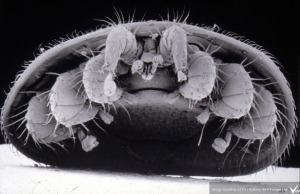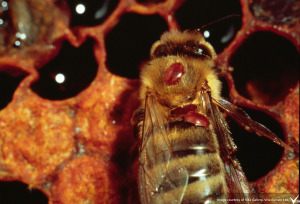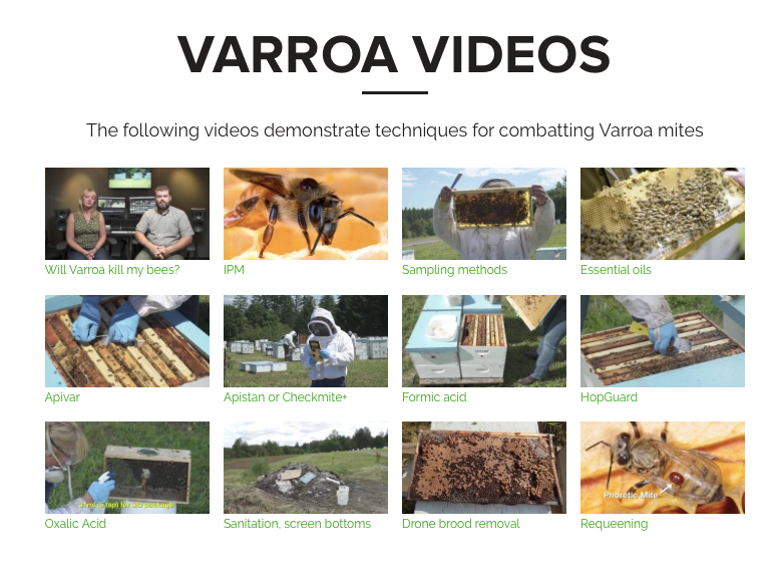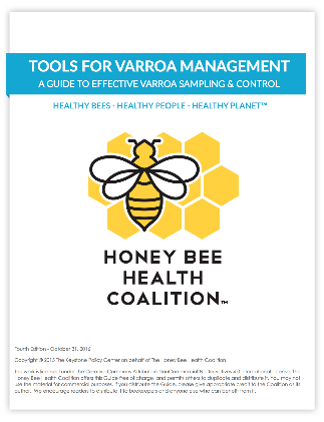Varroa Mites
Varroa destructor
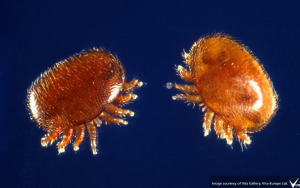
(Photo credit: Vita Bee Health)
Description
Of the pests and diseases currently plaguing honey bees, none is more prolific or of greater concern than Varroa mites. Indigenous to Asia, Varroa mites have only been in the United States since the late 1980’s when they were accidentally introduced into Florida. Their original host is the Asian honey bee, Apis cerana, which, unlike Apis mellifera, has natural defenses against Varroa that come from evolving together over time. Since their introduction into the United States, Varroa mites have spread across the entire US, decimating honey bee colonies. In response, universities, private cooperation’s, government agencies, and the like have dedicated copious amounts of time and money into finding an answer to such a monumental problem. Currently, no “silver bullet” exists, however, new research is being conducted all the time and a solution to such a convoluted problem is hopefully on the horizon.
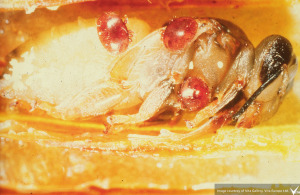
Varroa mites on a honey bee pupa. (Photo credit: Vita Bee Health)
Etiology
Varroa destructor is an ectoparasite that lives and feeds on the adult and pupal stages of honey bees. These mites are one of the largest ectoparasites in comparison to its host in the whole animal kingdom. Adult females are approximately the size of the head of a pin and oval-shaped. They are reddish brown in color and will darken with time. The adult female mites are the only stage that are found outside of honey bee cells, often found on the honey bees themselves. Varroa mites are phoretic, meaning they live on and interact with their environment via their host. Mites are often spotted on the thorax of the honey bee, however, they are well adapted to living between the segments of a honey bee’s abdomen. Mites are flat with claws that allow them to hang on to a honey bee.
After feeding on her honey bee host, the adult female mite will look for an opportunity to reproduce. She does this by crawling off her host into a cell with a larva that is about to be capped. This “foundress mite” will then feed on the larva and lay an unfertilized egg which will hatch within 6-7 days and develop into a male. Males are smaller, soft-bodied, and pale white in color and never leave the cell. Subsequent eggs are fertilized and are produced every 25-30 hours. Female nymphs are smaller and white when first hatched, similar to a male, but develop and darken with time. The foundress mites and offspring then alternate between feeding on the larva and defecating on the side of the cell until the cell is uncapped. The foundress and her female offspring will then leave the cell and start the cycle again. A foundress will produce approximately one offspring per worker cell and two per drone cell, and will therefore often prefer drone cells to worker cells.
While Varroa mites do not kill adult honey bees, they can weaken and shorten individuals’ lifespans and will ultimately kill the colony by outcompeting their host. Mites can kill immature bees before emergence, especially if multiple foundress mites enter the same cell. Immatures that do make it to adulthood are often riddled with a number of viral diseases that are contracted when mites feed. Varroa mites are vectors of numerous viruses including deformed wing virus, K-wing, acute paralysis, and Kashmir bee virus, amongst others.
Symptoms of a serious infestation can include: a spotty brood pattern, mites seen crawling on adults, the cells, and inside cappings, a diminishing adult population, adults with deformed wings, pupae uncapped prematurely, etc. Varroa mites are also associated with Parasitic Mite Syndrome, which can look very similar to European Foulbrood and is often the tell-tale sign of a colony close to collapse.
Spread
Varroa mites are phoretic, living on and moving around their environment via their host, the honey bee. They are spread within a colony when bees come into contact with one another. Mites are also spread between colonies and apiaries via robbing, drifting, swarming, and absconding. Varroa mites are unable to live for more than a few days without a host and therefore, you will not find Varroa mites in a dead out hive. They will have already been disseminated to other colonies on the bodies of robbing bees. When an infested colony begins to decline, robbers from surrounding colonies steal the honey and nectar left behind, and at the same time, become prime targets for Varroa mites which are inevitably carried back to a new colony. Beekeepers are also vectors of Varroa mites. Care should be taken when interchanging frames between colonies. The spread of mites can be an unintended consequence.
Control
It is essential that beekeepers be proactive about Varroa mites. To leave an infested colony to its own devices puts other colonies, including neighboring apiaries, at risk. Varroa mites are able to double in population in about a month and colonies with high numbers will not only decrease in vigor, but will eventually die from both mite damage as well as from the diseases that Varroa mites vector. Understanding the life cycle of the Varroa mite as well as knowing what mite levels are present in a colony is key.
Monitoring via sampling is essential to understanding current mite levels within a hive. The knowledge gained from sampling for mites allows the beekeeper to make an informed decision about whether treatment is needed. It is recommended to sample a least 4 times a year and then treat as needed. Sampling after a treatment is also vital to understand the efficacy of that treatment and decide whether the colony’s mite level is at an acceptable level. The recommended methods for sampling a colony are powdered sugar shakes or alcohol or soap washes. Detailed instructions for each sampling method, as well as information on how to interpret the results, can be found in the Honey Bee Health Coalition’s Tools for Varroa Management Guide, which is free for download.
If treatment is determined to be necessary for the welfare of the bees, the beekeeper must then decide what treatment(s) to use. It is recommended to use an IPM (Integrated Pest Management) approach to controlling mites. IPM utilizes both non-chemical and chemical methods in a proactive way to manage Varroa. It encourages rigorous monitoring, use of cultural, mechanical, and biological controls, and a rotation of chemicals to prevent mite resistance. While there are many methods of controlling mites, there is no “silver bullet”. The beekeeper may have to alternate the different methods of control, while diligently monitoring, to determine effectiveness. The Honey Bee Health Coalition’s Tools for Varroa Management Guide has a comprehensive list of treatments that are legal for use in the United States and Canada. The guide outlines, in detail, the facts as well as the pros and cons of each of the treatments. They also have a video series that gives a step-by-step demonstration on how to apply each of the treatments.
It is the responsibility of every beekeeper to understand Varroa mites and to intervene on behalf of their bees when necessary. This can mean the success or death of their colony. For more information about monitoring and controlling for Varroa mites, or to watch the treatment demonstration video series, check out the Honey Bee Health Coalition.
Click the below image to be directed to the Honey Bee Health Coalition’s Varroa Mite Videos
Click the image below to be directed to the Honey Bee Health Coalition’s Varroa Management Guide
The Honey Bee Health Coalition has also produced a Varroa Guide for Commercial Beekeepers (found here).

